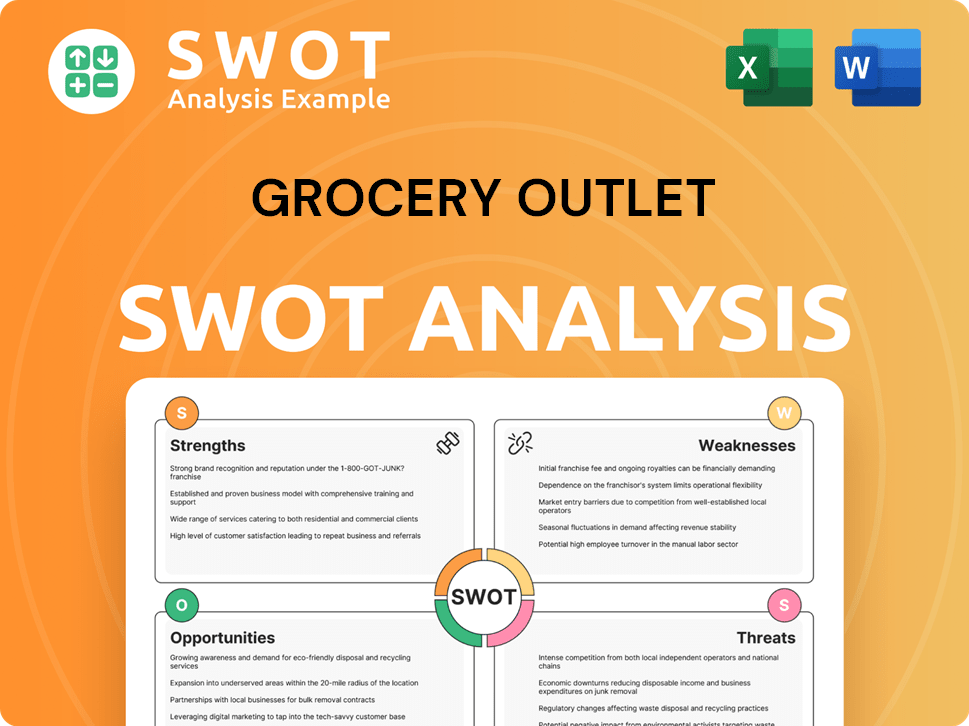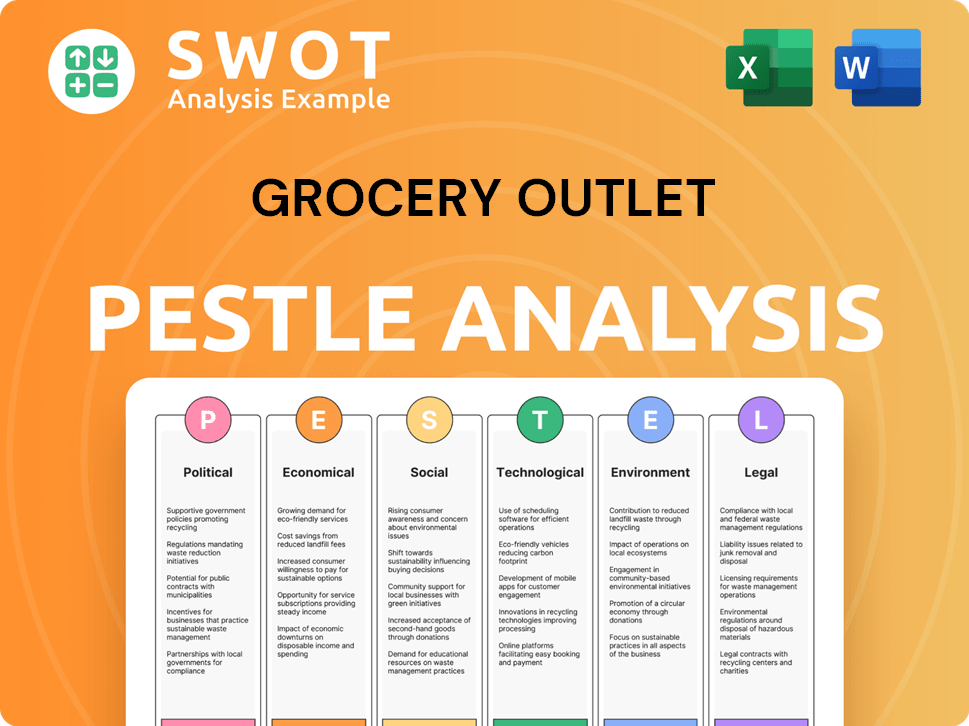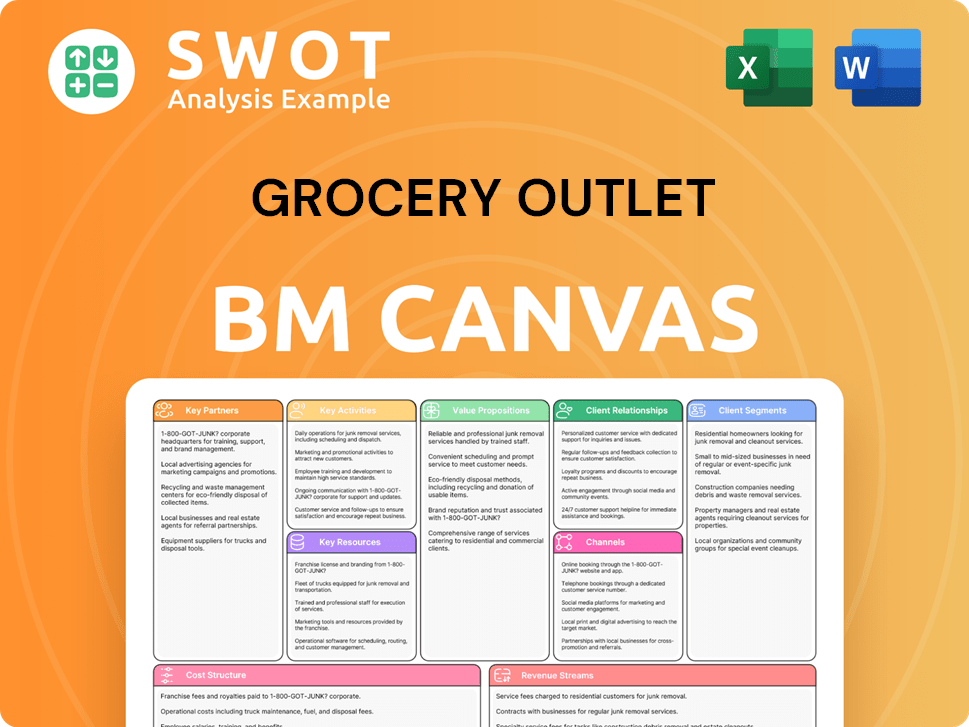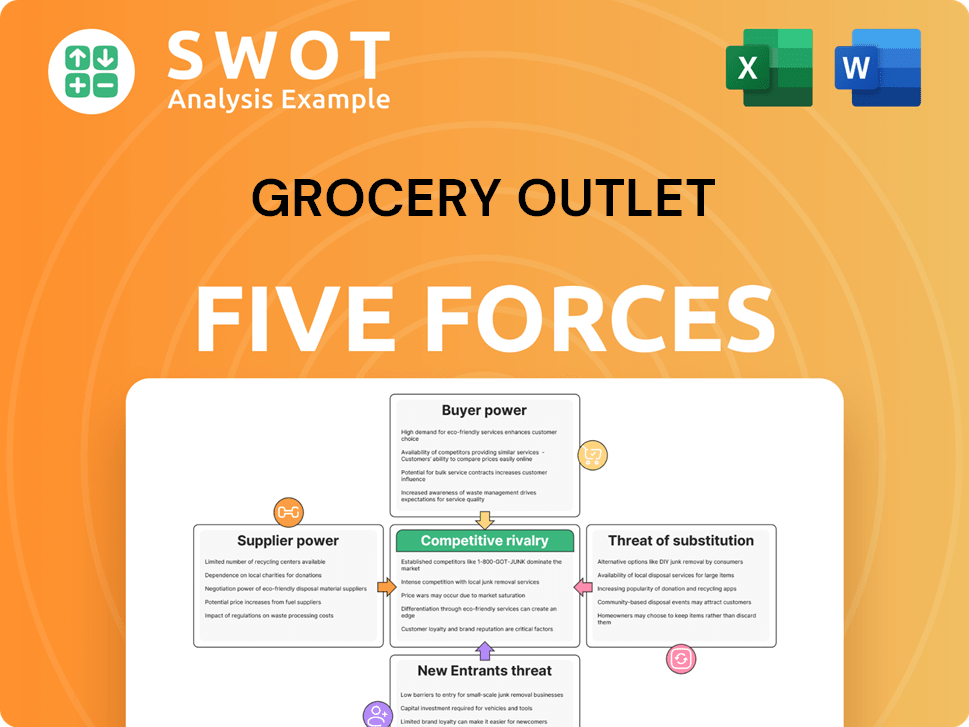Grocery Outlet Bundle
Can Grocery Outlet Continue Its Ascent in the Grocery Retail Landscape?
In the ever-evolving grocery sector, a strong growth strategy is crucial for survival. Grocery Outlet, a leading discount grocery retailer, has built a unique niche by offering name-brand products at unbeatable prices through opportunistic buying. This approach has allowed the company to attract value-seeking shoppers and expand its presence. Grocery Outlet's journey from its 1946 origins to its current status as a major player is a testament to its strategic evolution.

Grocery Outlet's success is rooted in its distinctive business model, which focuses on acquiring overstocked merchandise directly from suppliers. This creates a "treasure hunt" shopping experience, driving customer traffic and market share gains. To fully understand the Grocery Outlet SWOT Analysis, we must explore its expansion plans, technological innovations, and financial strategies. This analysis will delve into the Grocery Outlet growth strategy, its future prospects, and provide a comprehensive Grocery Outlet company analysis.
How Is Grocery Outlet Expanding Its Reach?
The Grocery Outlet growth strategy is primarily focused on expanding its physical presence and broadening its product offerings. This dual approach aims to capture a larger market share and enhance its overall financial performance. The company's expansion plans are carefully calibrated to balance growth with profitability, ensuring sustainable development.
A key element of the Grocery Outlet business model is its opportunistic buying strategy, which allows it to offer significant discounts to customers. This strategy, combined with strategic store locations and growth, has been instrumental in attracting a loyal customer base. The company's focus on value and unique product offerings contributes to its competitive advantage in the discount grocery retail sector.
Grocery Outlet's financial performance is closely tied to its expansion initiatives and product diversification efforts. By increasing its store count and introducing new private-label products, the company aims to drive revenue growth and improve its overall profitability. The company's ability to adapt to market changes and optimize its supply chain management is crucial for its long-term success.
In fiscal 2024, Grocery Outlet added 67 new stores, including 40 from the acquisition of United Grocery Outlet. This expansion brought the total store count to 533 by the end of fiscal 2024 and 543 by the end of Q1 2025. The company's expansion into six new states in the Southeast is a significant step in its growth strategy.
For fiscal 2025, Grocery Outlet plans to open between 33 and 35 net new stores. The focus will be on existing and high-priority adjacent markets to improve sales productivity and return on invested capital. This represents a moderated pace compared to previous plans as the company reassesses its store growth strategy.
In fiscal 2024, Grocery Outlet introduced over 180 new private-label SKUs across grocery and deli categories. The company plans to add approximately 150 more in 2025. This private label expansion aims to enhance the 'treasure hunt' experience and encourage larger purchases, contributing to profitability.
Grocery Outlet acquires surplus and closeout inventory at significant discounts from over 1,500 brand manufacturers. This allows the company to offer products at approximately 40% lower prices than traditional grocers. This strategy also supports food waste reduction by diverting excess products from landfills.
Grocery Outlet's expansion initiatives are designed to drive revenue growth and enhance its market position. The company's focus on both geographical expansion and product diversification is a key element of its long-term strategy. The company's ability to offer unique products at discounted prices is a significant competitive advantage.
- Strategic store openings in existing and adjacent markets.
- Introduction of new private-label products to enhance the customer experience.
- Leveraging the opportunistic buying model to maintain competitive pricing.
- Focus on improving sales productivity and return on invested capital.
Grocery Outlet SWOT Analysis
- Complete SWOT Breakdown
- Fully Customizable
- Editable in Excel & Word
- Professional Formatting
- Investor-Ready Format

How Does Grocery Outlet Invest in Innovation?
The company is actively leveraging innovation and technology to improve its operations and enhance customer experiences. This approach is crucial for its Grocery Outlet growth strategy, enabling it to adapt to changing market demands and maintain a competitive edge in the discount grocery sector. The company's focus on digital transformation and operational efficiency is a key element of its overall business strategy.
The company has been investing in digital upgrades to improve its inventory and financial reporting systems. These investments are designed to streamline operations and provide better data insights, supporting the company's Grocery Outlet future prospects. While some initial challenges arose during the transition, the company is actively working to resolve these issues and maximize the benefits of its technological investments.
The company's commitment to technology and innovation is evident in its various initiatives. These efforts are aimed at enhancing operational efficiency, improving customer engagement, and supporting its long-term growth objectives. This proactive approach is vital for the company's continued success and expansion in the competitive grocery market.
The company has been investing in digital transformation, including upgrades to its inventory and financial reporting platforms. These upgrades aim to streamline operations and improve data accuracy. Despite initial operational disruptions, the company is working to resolve these issues.
The company is rolling out a real-time order guide to improve inventory visibility and product assortment. This technology helps optimize inventory levels. This improves the efficiency of its supply chain.
The company plans to invest in lower-cost distribution centers for dry goods. These investments are intended to enhance capacity and improve inventory management. This is a key part of its operational efficiency strategy.
The company utilizes energy management systems in over 98% of its stores. These systems help control and monitor energy usage. This contributes to the company's sustainability efforts.
Approximately 17% of the company's stores use cloud-based refrigeration analytics. This technology helps reduce energy use and refrigerant leak rates. The company plans to expand this technology further.
The company has introduced a personalization app and a private label program to attract bargain hunters. These initiatives aim to foster customer loyalty. The expansion of private label offerings is a key part of this strategy.
The company's technological initiatives are designed to improve operational efficiency, inventory management, and customer engagement. The rollout of a real-time order guide and investments in lower-cost distribution centers are aimed at enhancing inventory visibility and capacity. Furthermore, the company's focus on energy management systems and cloud-based refrigeration analytics demonstrates its commitment to sustainability. These efforts support the company's Grocery Outlet business model and its Grocery Outlet expansion plans.
The company's technological initiatives are aimed at enhancing operational efficiency, improving customer engagement, and supporting its long-term growth objectives. These efforts are crucial for maintaining a competitive edge and driving sustainable growth. The company's commitment to innovation is evident in its various technology-driven projects.
- Real-Time Order Guide: Rollout to improve inventory visibility and product assortment.
- Distribution Centers: Investments in lower-cost distribution centers for dry goods to enhance capacity and inventory management.
- Energy Management Systems: Utilized in over 98% of stores to control and monitor energy usage.
- Cloud-Based Refrigeration Analytics: Used in 17% of stores to reduce energy use and refrigerant leak rates, with plans for expansion.
- Personalization App and Private Label: Introduced to attract bargain hunters and foster loyalty.
Grocery Outlet PESTLE Analysis
- Covers All 6 PESTLE Categories
- No Research Needed – Save Hours of Work
- Built by Experts, Trusted by Consultants
- Instant Download, Ready to Use
- 100% Editable, Fully Customizable

What Is Grocery Outlet’s Growth Forecast?
The financial outlook for Grocery Outlet is a key component of understanding its Competitors Landscape of Grocery Outlet and future prospects. The company's performance in fiscal year 2024 and the first quarter of 2025 reveals both strengths and areas needing improvement. Analyzing these financial trends is essential for assessing the Grocery Outlet growth strategy and its potential for long-term success.
In fiscal year 2024, Grocery Outlet reported a net sales increase of 10.1%, reaching $4.37 billion. This growth was supported by a 2.7% increase in comparable store sales. However, net income for the year was $39.5 million, a significant decrease from the $79.4 million recorded the previous year. This decline was primarily due to lower gross margins and higher operating expenses.
The gross margin decreased by 110 basis points to 30.2% in fiscal 2024, significantly impacted by inventory shrinkage. This issue stemmed from systems conversion challenges. Despite these challenges, the company demonstrated resilience, with net sales in Q1 2025 rising by 8.5% to $1.13 billion, and comparable store sales increasing by 0.3%. The gross margin improved to 30.4% in Q1 2025.
Net sales grew by 10.1% to $4.37 billion.
Comparable store sales increased by 2.7% in fiscal 2024 and 0.3% in Q1 2025.
Net income for fiscal 2024 was $39.5 million, a decrease from $79.4 million the previous year.
The gross margin decreased to 30.2% in fiscal 2024 but improved to 30.4% in Q1 2025.
For fiscal year 2025, Grocery Outlet has maintained its guidance for adjusted earnings per share (EPS) in the range of $0.70-$0.75 and revenue between $4.7 billion and $4.8 billion. However, the company has adjusted its comparable store sales growth forecast to 1.0-2.0%, down from the previous range of 2.0-3.0%. This adjustment reflects the current market dynamics and the company's strategic focus on sustainable growth.
The company projects revenue between $4.7 billion and $4.8 billion for fiscal year 2025.
Adjusted EPS is expected to be in the range of $0.70-$0.75 for fiscal year 2025.
Comparable store sales growth is forecasted at 1.0-2.0% for fiscal year 2025.
A restructuring plan initiated in Q4 2024 continues in fiscal 2025 to improve profitability.
Total costs for the restructuring plan are estimated at $59 million to $61 million.
Cash expenditures related to the restructuring plan are expected to be $40 million to $42 million.
The company initiated a restructuring plan in the fourth quarter of 2024, continuing into fiscal 2025. This plan aims to enhance long-term profitability and cash flow. The total costs associated with this restructuring are projected to be between $59 million and $61 million, with cash expenditures estimated at $40 million to $42 million. At the end of fiscal 2024, Grocery Outlet had $62.8 million in cash and cash equivalents and a total debt of $477.5 million. These financial figures are crucial for understanding the Grocery Outlet business model and evaluating its expansion plans.
Grocery Outlet Business Model Canvas
- Complete 9-Block Business Model Canvas
- Effortlessly Communicate Your Business Strategy
- Investor-Ready BMC Format
- 100% Editable and Customizable
- Clear and Structured Layout

What Risks Could Slow Grocery Outlet’s Growth?
The success of the Grocery Outlet's growth strategy faces several potential risks and obstacles. These challenges span market competition, economic conditions, operational issues, and the unique aspects of their business model. Understanding these risks is crucial for assessing the Grocery Outlet's future prospects.
Intense competition from various retail formats, including traditional supermarkets, online retailers, and other discount stores, puts pressure on Grocery Outlet's market share. Economic factors, like inflation and unemployment, can also significantly impact consumer spending habits, affecting the company's financial performance. The company must navigate these external pressures to maintain its growth trajectory.
Operational challenges, such as supply chain disruptions and inventory management, could hinder the company's ability to meet demand and maintain profitability. The independent operator (IO) model, while fostering a unique entrepreneurial culture, also presents risks in attracting and retaining qualified operators. Regulatory changes and the ability to adapt to them also pose challenges. These factors could impact the Grocery Outlet's ability to execute its expansion plans.
The discount grocery market is highly competitive, with established players like Walmart, Kroger, and Aldi. These competitors often have greater resources and market presence. Grocery Outlet must differentiate itself to maintain its competitive advantage.
Economic downturns and changes in consumer spending habits can significantly impact Grocery Outlet's sales. Elevated inflation and unemployment rates can reduce consumer purchasing power. The company's financial performance is closely tied to these economic indicators.
Supply chain disruptions and inventory management issues can impact Grocery Outlet's ability to maintain product availability and control costs. The late August 2023 ERP system conversion caused significant disruptions, affecting operations and gross margins in fiscal 2024. Store operational problems also present challenges.
Attracting and retaining qualified IOs is critical to Grocery Outlet's expansion strategy. Managing IOs' business operations and ensuring consistent store performance is also essential. The IO model's success depends on the company's ability to support and manage its IOs effectively.
Changes in food safety regulations, labor laws, and environmental standards can increase operating costs. The company must comply with all relevant regulations to avoid penalties and maintain its reputation. Adapting to these changes is crucial for long-term sustainability.
The company's restructuring plan, including terminating leases and layoffs, indicates challenges in cost management and expansion strategy. Approximately 40 full-time workers were laid off in Q1 2025. These actions reflect the need to adapt to changing market conditions and improve profitability.
Grocery Outlet's opportunistic buying model relies on its ability to secure discounted products. Supply chain disruptions can limit this access. Efficient supply chain management is critical for maintaining its value proposition. Recent data indicates that supply chain issues continue to affect the retail sector.
Effective inventory management is crucial for minimizing waste and maximizing profitability. The issues with the ERP system conversion in late August 2023 highlighted the importance of robust inventory control systems. Proper inventory management directly impacts financial performance.
Consistent store operations are essential for providing a positive customer experience. Operational problems can negatively impact sales and brand reputation. Grocery Outlet must maintain high operational standards across all its locations to ensure customer satisfaction. Data from 2024 shows the importance of operational efficiency in retail.
The company's financial performance is subject to these various risks. Gross margins and revenue growth trends are key indicators of success. The restructuring plan aims to improve profitability. Monitoring financial metrics is vital for assessing the company's long-term viability.
Grocery Outlet Porter's Five Forces Analysis
- Covers All 5 Competitive Forces in Detail
- Structured for Consultants, Students, and Founders
- 100% Editable in Microsoft Word & Excel
- Instant Digital Download – Use Immediately
- Compatible with Mac & PC – Fully Unlocked

Related Blogs
- What are Mission Vision & Core Values of Grocery Outlet Company?
- What is Competitive Landscape of Grocery Outlet Company?
- How Does Grocery Outlet Company Work?
- What is Sales and Marketing Strategy of Grocery Outlet Company?
- What is Brief History of Grocery Outlet Company?
- Who Owns Grocery Outlet Company?
- What is Customer Demographics and Target Market of Grocery Outlet Company?
Disclaimer
All information, articles, and product details provided on this website are for general informational and educational purposes only. We do not claim any ownership over, nor do we intend to infringe upon, any trademarks, copyrights, logos, brand names, or other intellectual property mentioned or depicted on this site. Such intellectual property remains the property of its respective owners, and any references here are made solely for identification or informational purposes, without implying any affiliation, endorsement, or partnership.
We make no representations or warranties, express or implied, regarding the accuracy, completeness, or suitability of any content or products presented. Nothing on this website should be construed as legal, tax, investment, financial, medical, or other professional advice. In addition, no part of this site—including articles or product references—constitutes a solicitation, recommendation, endorsement, advertisement, or offer to buy or sell any securities, franchises, or other financial instruments, particularly in jurisdictions where such activity would be unlawful.
All content is of a general nature and may not address the specific circumstances of any individual or entity. It is not a substitute for professional advice or services. Any actions you take based on the information provided here are strictly at your own risk. You accept full responsibility for any decisions or outcomes arising from your use of this website and agree to release us from any liability in connection with your use of, or reliance upon, the content or products found herein.